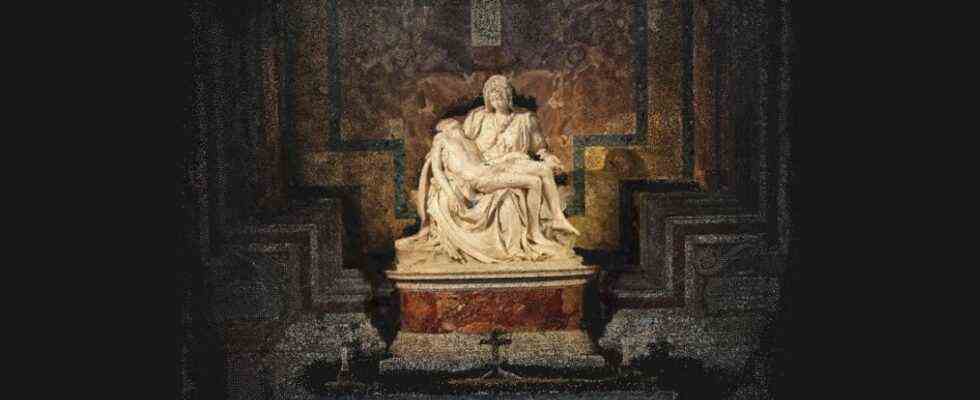St. Peter’s Basilica is one of the most famous buildings. Almost everyone has seen the basilica in the Vatican in Rome in real life, on film or in photographs. The only question is: what of it is remembered? The dome, the columns, the “Roman Pietà” by Michelangelo? And anyway: what do you actually notice when you visit St. Peter’s Basilica or in Rome? Do you really see the cathedral, the city or do you just check off the sights suggested by the travel guide and take a photo of them? The director and visual artist Philip Gröning, who became known for films like “The Great Silence”, felt that way during a stay at Villa Massimo in Rome in 2016. That all tourists “walked through the city like remote-controlled … One check, no sight”.
But it did not stop with this perception, which was “unsettling” for him. Instead, this has led to artistic works that can currently be seen in the exhibition “Image Processes” at the Bavarian Academy of Fine Arts. To this end, Gröning, who held a visiting professorship at the Munich Art Academy in 2018 and 2019, continued his thoughts into a thought experiment. This culminates in the question of how the Facebook or Instagram server perceives Rome or the world in general. That is where our vacation photos end up on social media. That is why the 62-year-old had an artificial intelligence (AI) search for photographs of Rome and “asked” them to use them to reconstruct images of St. Peter’s Basilica, from inside, outside or of the “Pietà”. And the result is absolutely amazing.
The AI has a statistical worldview and sees people as “errors”
So you can now see a St. Peter’s Basilica on four light boxes that has no floor, only half columns. The dome, it is fraying on the side. The “Pietà” is heavily pixelated and there are irritations that cannot really be explained. The reason? What is missing was simply not photographed, at least not by a lot of people. And you don’t see people in the pictures because the AI works according to statistics and constants and calculates everything that is not repeated as “errors”. Neither is there anything 100 or 0 percent for the AI. For them there are only values in between, because the probability does not know anything “one hundred percent”. Instead, something is 31 or 67 percent “real” to them. As a person, however, you can’t imagine much by this.
Free-floating St. Peter’s Basilica – what is missing was simply not photographed and therefore not found by the AI.
(Photo: Philip Gröning)
What do you call something like that? A “statistical worldview” or a “purely statistical concept of existence”, as Gröning explains on the day the exhibition opens. And that’s exactly what he wants to depict with his pictures. How come? Because for him, AI is an “independent, new medium”, “with completely different design options,” says Gröning. “A separate cultural space that we have to deal with”. That’s why he had the Löwenbräu tent at Oktoberfest reconstructed by an AI, also based on photos from the Internet. What amazes in the picture shown? You can see blue shirts and pink dirndls. Because the AI apparently perceives these as “constants”. Others frayed, lost in vague geometric shapes, which is also proven by the sculptures that Gröning had milled on the basis of selected motifs in Shanghai. This includes the hop garland in the tent, which as a sculpture looks more like a meteorite rock.
Smarter recognition of design and art as a translation error
For Gröning this is a failed attempt at “design recognition”, which we as humans have been practicing for millions of years, but which AI is only just learning. Or to put it another way: They are “cultural translation errors”, as we know them from art history and which he describes as “the great positive drivers” of culture. Such “mistakes” are also shown by photos that the artist made of the Munich Eisbach and where the smartphone’s AI did not clearly recognize the foreground and background. Although, as I said, human perception is not that far away either.
This, in turn, is shown by other works for which the artist photographed flowers, Lake Starnberg or Michelangelo’s Moses in San Pietro in Vincoli in the dark with an analog camera and traced them with a laser pointer. The background: As humans, we do not see “real” bodies, but, according to Gröning, “always only light and the present” and a (prefabricated) shape. In any case, the result is “light drawings” that are reminiscent of abstract expressionism and with which he wants to sharpen perception anew. Because as you can see: seeing is not that easy at all.
Image processes – work by Philip Gröning, until December 22nd, Bavarian Academy of Fine Arts, Max-Joseph-Platz 3

